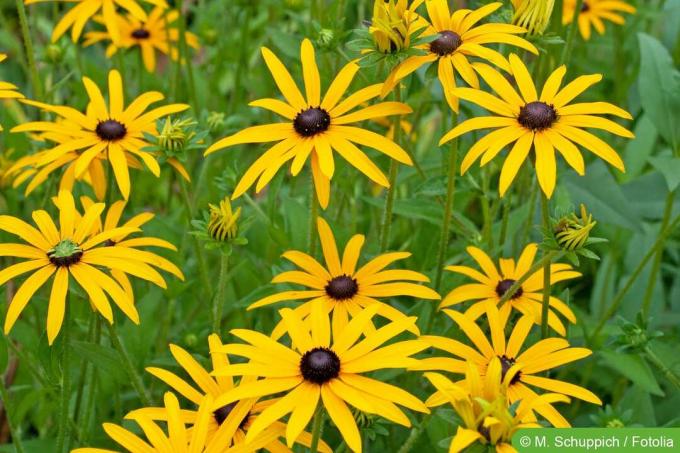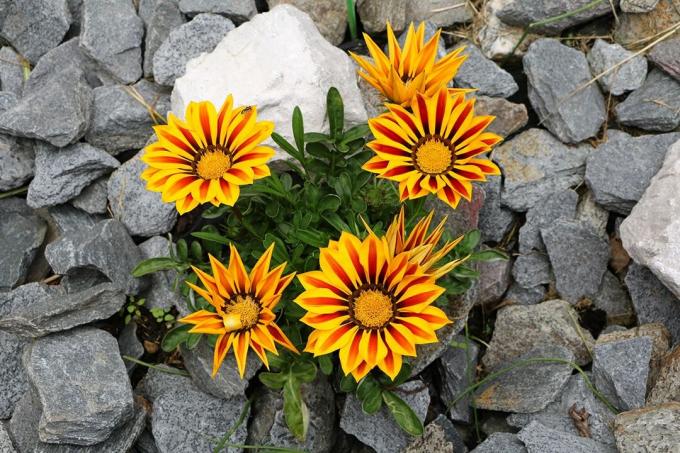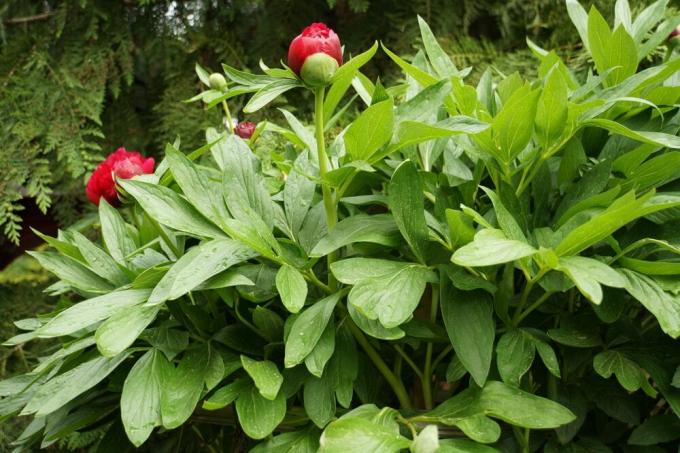

Table of contents
- location/soil
- sowing
- Plant
- Pour
- Fertilize
- Care
- multiply
- Propagation by cuttings
- hibernate
- Diseases
- Known Varieties
- frequently asked Questions
- Worth knowing about coneflowers shortly
The yellow coneflower comes from North America and is around 50 to 70 cm high. It grows upright, forms dense leafy bushes and runners. Its leaves are pointed and narrow. The surface of the leaves is hairy and they have a toothed edge. The bowl-shaped flower is deep golden yellow with a round, raised flower center. The petals are arranged in a radial pattern and slope slightly downwards. The yellow coneflower blooms from August to October. The flowers last a long time in the vase.
location/soil
The light intensity has an influence on the growth and the willingness to flower. The yellow coneflower therefore needs a sunny location with moist, nutrient-rich soil. Alternatively, a partially shaded location is acceptable. The soil should be well drained. The yellow coneflower does not tolerate waterlogging. By the way: the yellow coneflower does not bloom in the shade
Tip:
Echinacea will also thrive in loamy soil if it's kept moist!
Up to ten flowers develop per plant. The coneflower spreads so densely that weeds hardly get a chance. Combine the yellow coneflower with ornamental grasses, in perennial borders, with delphiniums and in borders. Colored plant partners are veiled verbena, phlox and asters. In an exposed position, a group of coneflowers forms an eye-catcher that cannot be overlooked.
sowing
Propagation with seeds from specialist shops is possible over the entire vegetation period from April to September. The seeds are placed in a deep seed tray or flower pot with fine-grained soil. The seeds must be planted at least 30 cm to 40 cm deep. The seeds are covered with soil and watered. The germination period is two to three weeks. After a short time, the seedling can be placed outdoors. The planting depth and the planting distance for the seeds outdoors are around half a meter.
Tip:
The Goldsturm variety can be propagated particularly well by seeds!
The seeds can be sown as early as February on the windowsill or in the greenhouse. Then the coneflower has a growth advantage over sowing outdoors. The ice saints have to be awaited before the young plants can be released.
Plant
The perennial grows 40 cm to 60 cm high and 50 cm to 70 cm wide. This results in a planting distance of between 40 cm and 60 cm per square meter.
Pour
The yellow coneflower tolerates short dry and wet periods. On average, it needs normal soil moisture. It has no special requirements and is best watered in the evening in summer. Did you know? Regular watering extends the flowering period in autumn!
Fertilize
- incorporate compost regularly
- stimulate growth in spring with mineral fertilizer
- Spread complete fertilizer around the perennial before flowering and carefully work it into the soil
Care
Withered flowers are cut off with scissors. This increases the attractiveness and promotes the formation of new flowers. The soil around the perennial can be loosened to ensure good permeability. In winter, the yellow coneflower is shortened to 15 cm above the ground.
multiply
Without division, the yellow coneflower quickly spreads. Densely growing perennials can be propagated by division. The perennial is lifted out of the ground with a fork and divided into two or more halves. When digging in, keep a sufficient planting distance and measure the planting hole generously so that the coneflower can spread well.
Tip:
Untangle the densely overgrown roots by hand to reduce injury! Coneflowers are best propagated by division in spring.
Propagation by cuttings
Alternatively, the yellow coneflower can be propagated by cuttings. To do this, select leaf stands without flowers and with at least three pairs of leaves. Cut off the cuttings with a sharp knife and plant them about 3 cm deep in potting soil. Water the cuttings generously and then keep them moderately moist for six weeks. Enough roots should now have formed so that the cutting can be planted outdoors. Cuttings can be propagated particularly well in late summer. They grow on the windowsill over the winter and then start in the garden in the spring.
Tip:
Don't water the cuttings too much over the winter, but don't let the soil dry out either!
hibernate
The withered stalks of the yellow coneflower are cut off a hand's breadth above the ground in autumn. If you leave the inflorescences standing, you offer food to the garden birds, which are still picking out the flower seeds. The yellow coneflower overwinters outdoors without winter protection. Its densely branched roots reach deep enough into the earth so that the frost cannot harm them.
Tip:
If you leave the coneflower as an ornament over the winter, you can also cut back the perennial in early spring in February or March.
Diseases
The yellow foxglove can be attacked by aphids. The leaves then show brown spots and feeding tunnels. Affected leaves are removed and burned. If the leaflets spread, treatment with an insecticide is indicated. Another disease is powdery mildew from too dark a stand. By the way: Snails don't like coneflowers!
Known Varieties
The purple coneflower is widespread with over 23 species. It grows in America at altitudes of up to 2,800 meters. Very decorative types are:
- Rudbeckia fulgida var. sullivantii 'Gold Storm'
- Rudbeckia lanciniata 'Goldball'
- Rudbeckia nitida 'Autumn Sun'
- Rudbeckia fulgida 'Rubinstein'
- Rudbeckia fulgida 'Goldsteinii'
frequently asked Questions
They must have grown compact. Brown leaves are taboo.
Six hours of sunshine is optimal.
A handful of compost in the planting hole promotes growth and covers the nutrient requirements at first.
Planted in groups, the perennial produces a sea of yellow flowers.
Worth knowing about coneflowers shortly
The coneflower perennial is an extremely popular plant from the perennial genus. Thanks to their bright yellow color, they are very common in beer gardens. But also in front yards the purple coneflower cuts a fine figure. The plant itself includes about 40 different forms, in which the sizes in particular vary greatly. The smallest of its kind is just 40 cm high and is therefore ideal for planting in flower pots or tubs. The largest of its kind, on the other hand, reaches a proud height of two meters.
Location
- The name "coneflower perennial" already suggests it: The plant prefers a sunny and warm location.
- stands the shrub too damp or a lot of rain, the plant shows it directly and brownish spots appear on the petals.
- If the location is nice and sunny and warm again, the brown spots will simply grow out.
- The soil should also be rich in nutrients. Soil rich in humus is ideal.
So that coneflower comes into its own, you should plant it next to magnificent perennials. Flame flowers, sage, Indian nettles are ideal here, but the coneflower also shines in all its beauty next to summer lilac and thus offers a wonderful color contrast.
Care
- So that you can enjoy the beauty of the coneflower for a long time, you should regularly remove the faded flowers.
- Also watch out for diseases that are usually caused by powdery mildew. In such cases, you should take countermeasures quickly.
propagation
- Use the early spring when the first new shoots appear. However, you can also try your hand at seed cultivation.
- To cut the purple coneflower, spring from February to March is ideal.
- As an alternative, however, you can also cut it back after flowering. To do this, simply cut it hand-breadth above the ground.
- If you want to plant new perennials, the distance should be at least 30 cm to one meter, depending on the type of perennial.
 garden editorial
garden editorial I write about everything that interests me in my garden.
Learn more about flowers

Midday gold, Gazania: proper care and wintering
The midday gold, which impresses with its colorful and sun-loving flowers, is one of the most popular perennials for local gardeners. The right tips for caring for and overwintering the Gazania have been put together for you here.

Caring for, overwintering and cutting asters | Instructions
The radiant flowers of the asters enchant every garden as well as in pots, terraces and balconies, depending on the variety, from May until well into autumn. Caring for the perennials is not that difficult if everything is known about wintering and cutting.

Magnificent pier, Astilbe: care instructions from A - Z
Astilbe is very popular in the garden. Still, gardeners need to consider a few things if they want the plants to thrive. In our A-Z care instructions, you will learn everything you need to know about the splendor, from flowering to winter protection.

California Poppy, Eschscholzia californica: Care Instructions
Hardly any garden plant is as easy to care for as Californian poppy (Eschscholzia californica), which, with its golden yellow flowers, is a feast for the eyes in the home garden. In order to ensure the bright sea of flowers, a few points should be considered with regard to care.

17 hardy bee-friendly flowers
There has been talk of bee deaths for years. You absolutely need help to survive. Bees are an important part of our ecosystem. Garden owners can also help the small insects with the design of their green oasis.

When do peonies bloom? | Beginning and duration of the flowering period
Peonies are garden perennials that, after a few years, form a veritable sea of flowers in early summer. The individual flowers are long-lasting and are also suitable for cutting. Depending on the variety, they bloom in different colors. But when exactly is the heyday?



